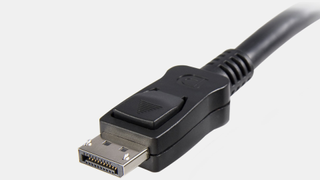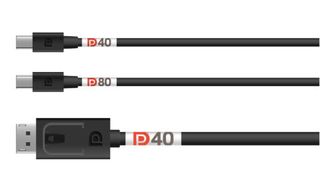VESA Announces DisplayPort 2.0 UHBR Certification
HDMI 2.1 issues expected to be avoided by VESA's UHBR certification program.

The Video Electronics Standards Association (VESA) on Monday kicked off its certification program for upcoming DisplayPort 2.0 cables. The new program will certify DP40 and DP80 cables to clearly distinguish between cables offering different bandwidth and therefore display capabilities. The move is aimed to avoid the confusion that HDMI 2.1-branded cables with different capabilities caused in the consumer electronics world.
VESA certified DP40 cables must support up to the UHBR 10 10 Gbps data transfer rate, whereas VESA certified DP80 will support UBHR 13.5 and UHBR 20 at 13.5 Gbps and 20 Gbps data transfer rates, respectively. The same applies to monitors and graphics adapters (both integrated and standalone) as well as Mini DisplayPort and USB-C cables supporting DP_Alt_Mode.

Modern DisplayPort 1.3/1.4 cables and appropriate display devices support resolutions of up to 7680×4320 at 30 Hz with display stream compression (DSC) using HBR3 transmission mode and 32.4 Gbps/25.92 Gbps raw/effective bandwidth. By contrast, DisplayPort 2.0 specification intends to support resolutions of up to 7680x4320 at 85 Hz or 10K at 60 Hz using UHBR 20 transmission mode (at 80.00/77.37 Gbit/s bandwidth) with deep colors and without DSC and even higher resolutions (e.g., 16K) with it.
But not all display devices support an 8K resolution with deep colors, which is why they do not need UHBR 20 transmission mode. This is why the DisplayPort 2.0 specification also supports UBHR 10 (at 40 Gbps raw bandwidth), UBHR 13.5 (at 54 Gbps raw bandwidth). Formally, all DisplayPort 2.0-badged cables are better than DisplayPort 1.3/1.4 cables in terms of supported bandwidth, but the difference between 2.0 cables is significant enough to create a mess. This is why VESA starts this certification program to clearly distinguish between UHBR 10 (called DP40) and UHBR 13.5/UHBR 20-supporting cables (called DP80) and outputs.
| Row 0 - Cell 0 | Transmission Mode | Raw Bandwidth | Maximum Display Capability | Cable Marking |
| DisplayPort 1.3/1.4 | HBR3 | 32.4 Gbps | 8Kp30 without DSC | HBR3 |
| DisplayPort 2.0 | UHBR 10 | 40 Gbps | 8Kp30 without DCC | DP40 |
| DisplayPort 2.0 | UHBR 13.5 | 54 Gbps | 8Kp60 without DSC | DP80 |
| DisplayPort 2.0 | UHBR 20 | 80 Gbps | 10Kp60 without DSC | DP80 |
VESA says that various video source (i.e., graphics adapters) and display products are undergoing testing in the DisplayPort UHBR Certification Program now, and should complete early certification shortly.
"No matter how high the performance of your graphics card and monitor are, the resulting image quality can still be limited by the cable used to connect those devices," said James Choate, compliance program manager for VESA."Thanks to improvements in both the DisplayPort connector and cable design, the new VESA certified DP40 and DP80 UHBR cables enable consumers to get the highest performance possible from their VESA certified devices. These new cables are backed by VESA’s UHBR Certification Program, which provides added assurance that if your cable has the DP40 or DP80 logo from VESA, it will meet the specs for the highest data rates supported by current and future products certified by VESA."
Stay on the Cutting Edge
Join the experts who read Tom's Hardware for the inside track on enthusiast PC tech news — and have for over 25 years. We'll send breaking news and in-depth reviews of CPUs, GPUs, AI, maker hardware and more straight to your inbox.

Anton Shilov is a Freelance News Writer at Tom’s Hardware US. Over the past couple of decades, he has covered everything from CPUs and GPUs to supercomputers and from modern process technologies and latest fab tools to high-tech industry trends.
-
Soaptrail ReplyAdmin said:VESA initiates DisplayPort UHBR certification program for DisplayPort 2.0 cables.
VESA Announces DisplayPort 2.0 UHBR Certification : Read more
This is better but I think there is still room for improvement. Is there a material change between DP40 and DP80 cables? I am guessing most people will want DP80 to avoid any issues and prevent rebuying cables due to future upgrades. Maybe there is length restrictions that DP40 exceeds compared to DP80 thus we have two cables instead of one. -
Sluggotg If the cable is too long to be certified DP80, it won't be marked DP80.Reply
I am thrilled Display Port folks are trying to help us when we buy cables. The HDMI guys don't care. They are actually helping the manufacturers Con Us by saying "It is HDMI 2.1".. but it is not 48mbps, because 2.1 no longer means that, (but then again.. it might...who knows). This just sells more stuff because you might not be buying what you need because they are no longer Marked with the actual specs. -
TJ Hooker What confusion is there with HDMI 2.1 cables? The issue is with the devices (and which features they support), not the cables.Reply
Most Popular






